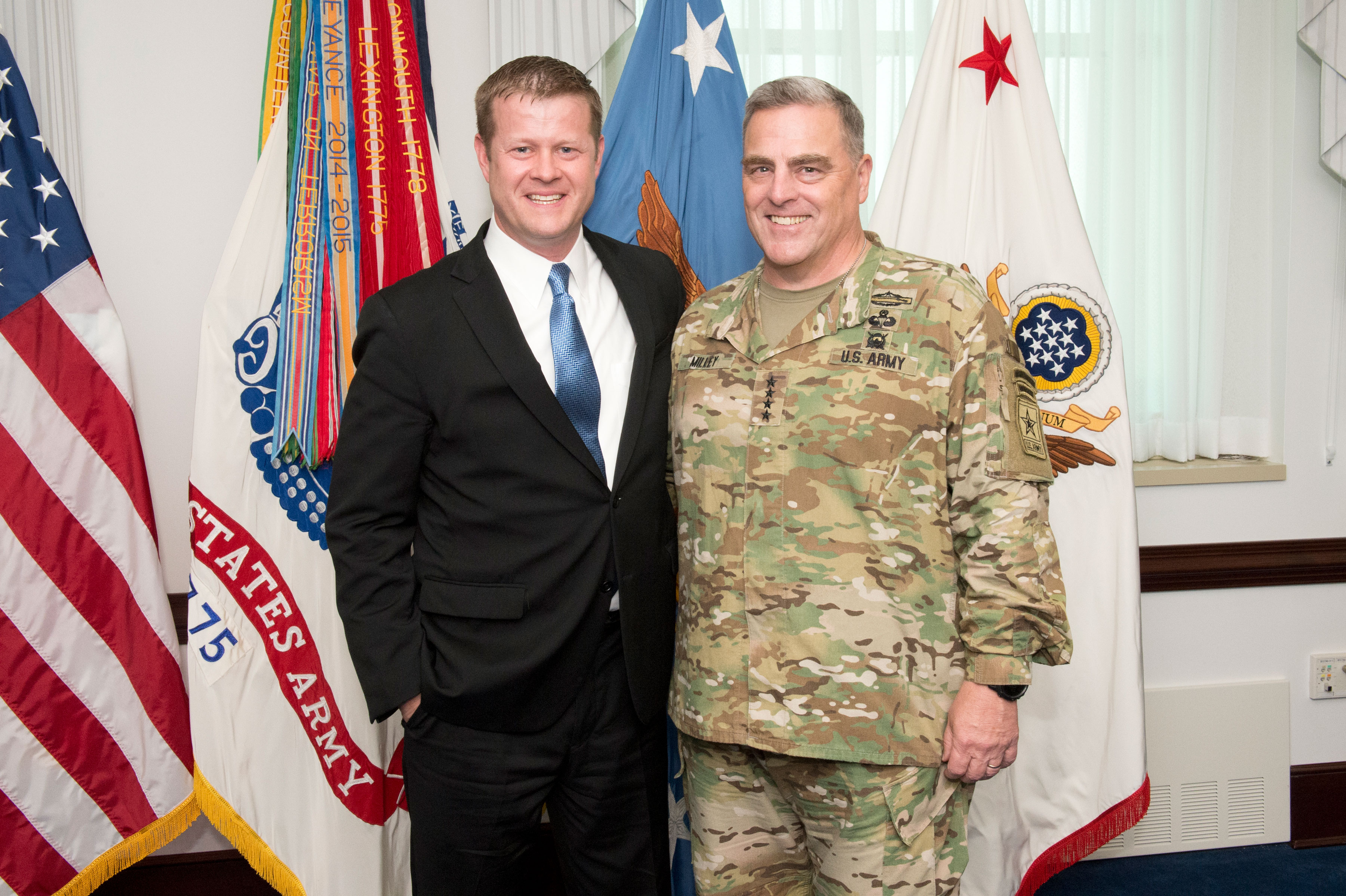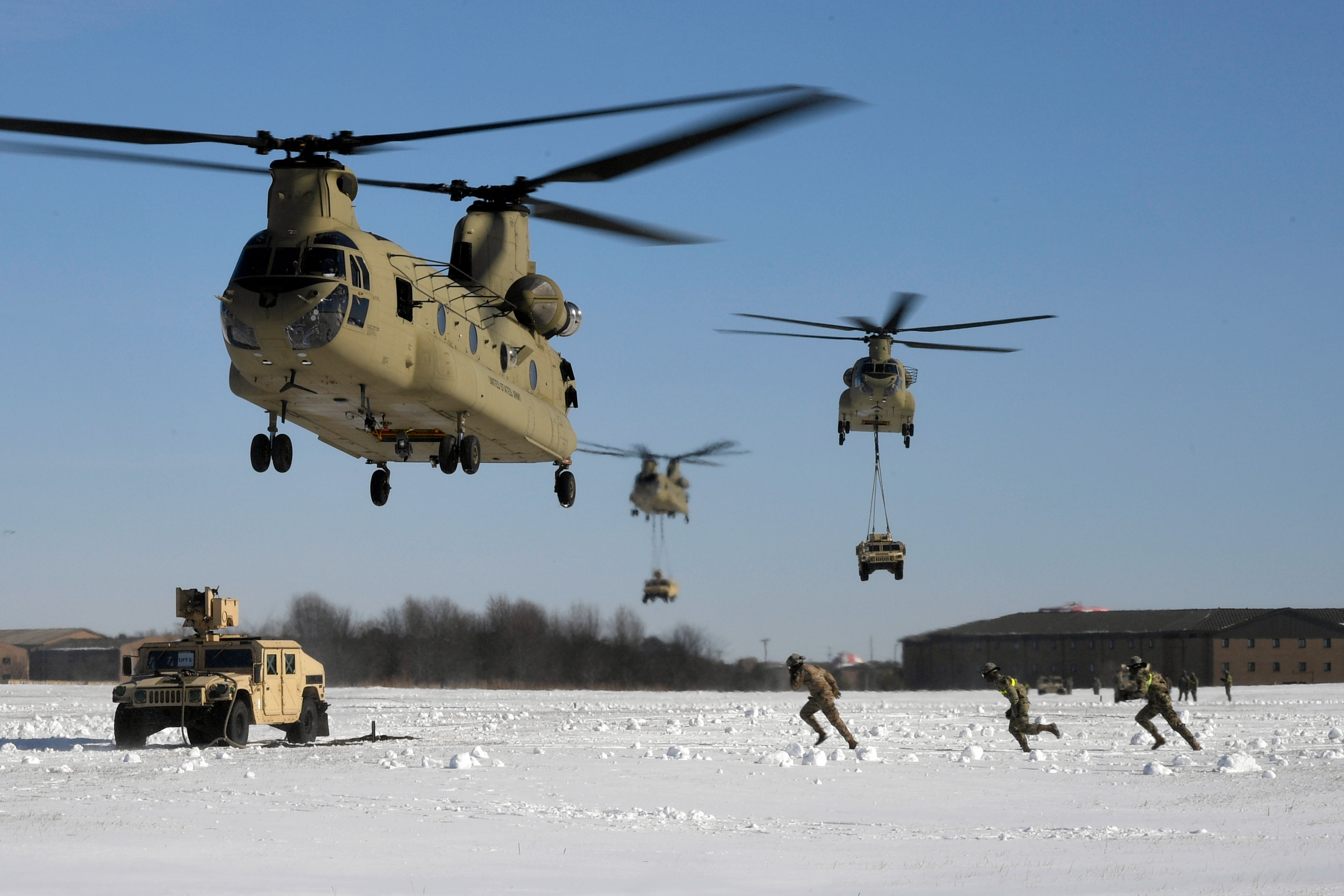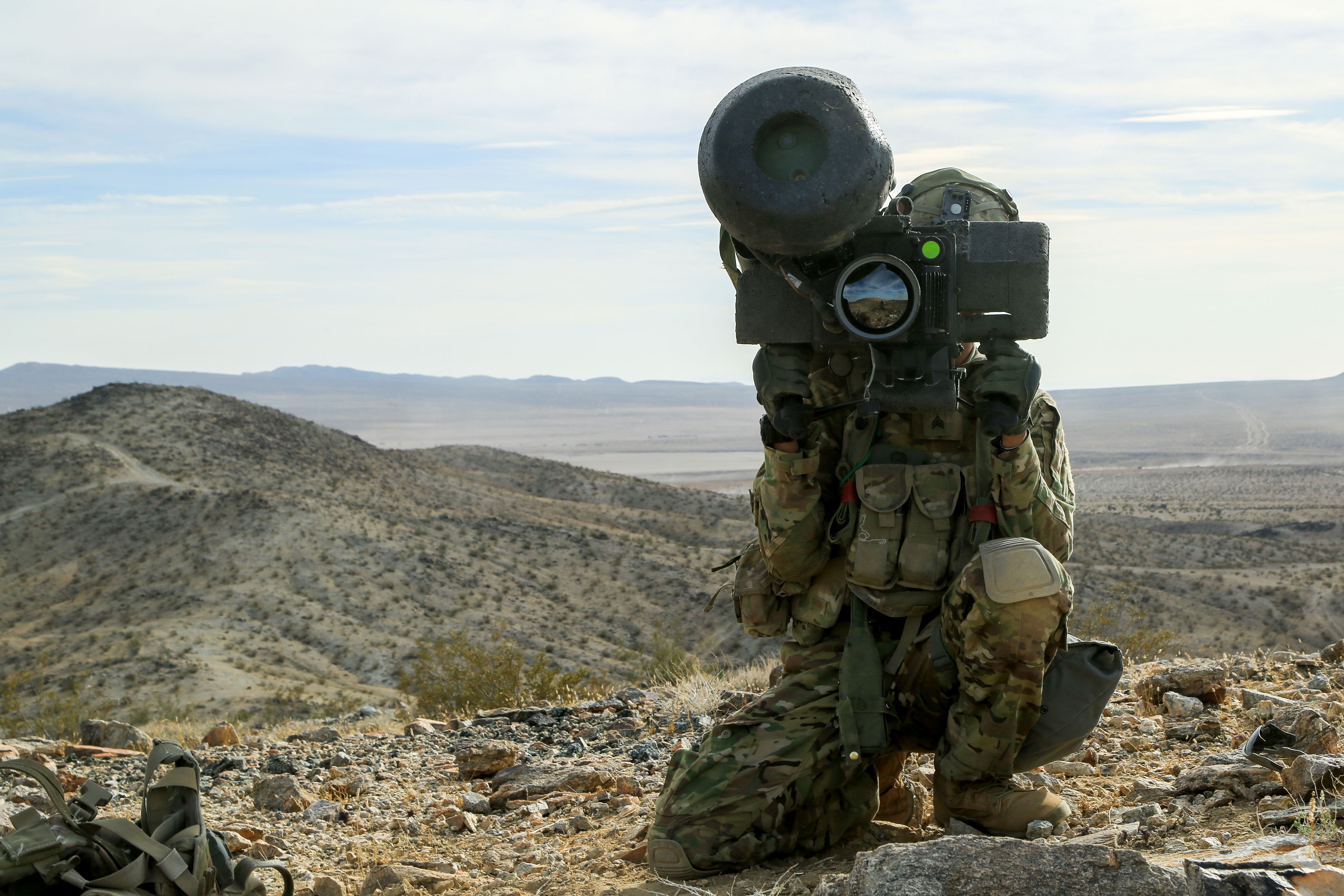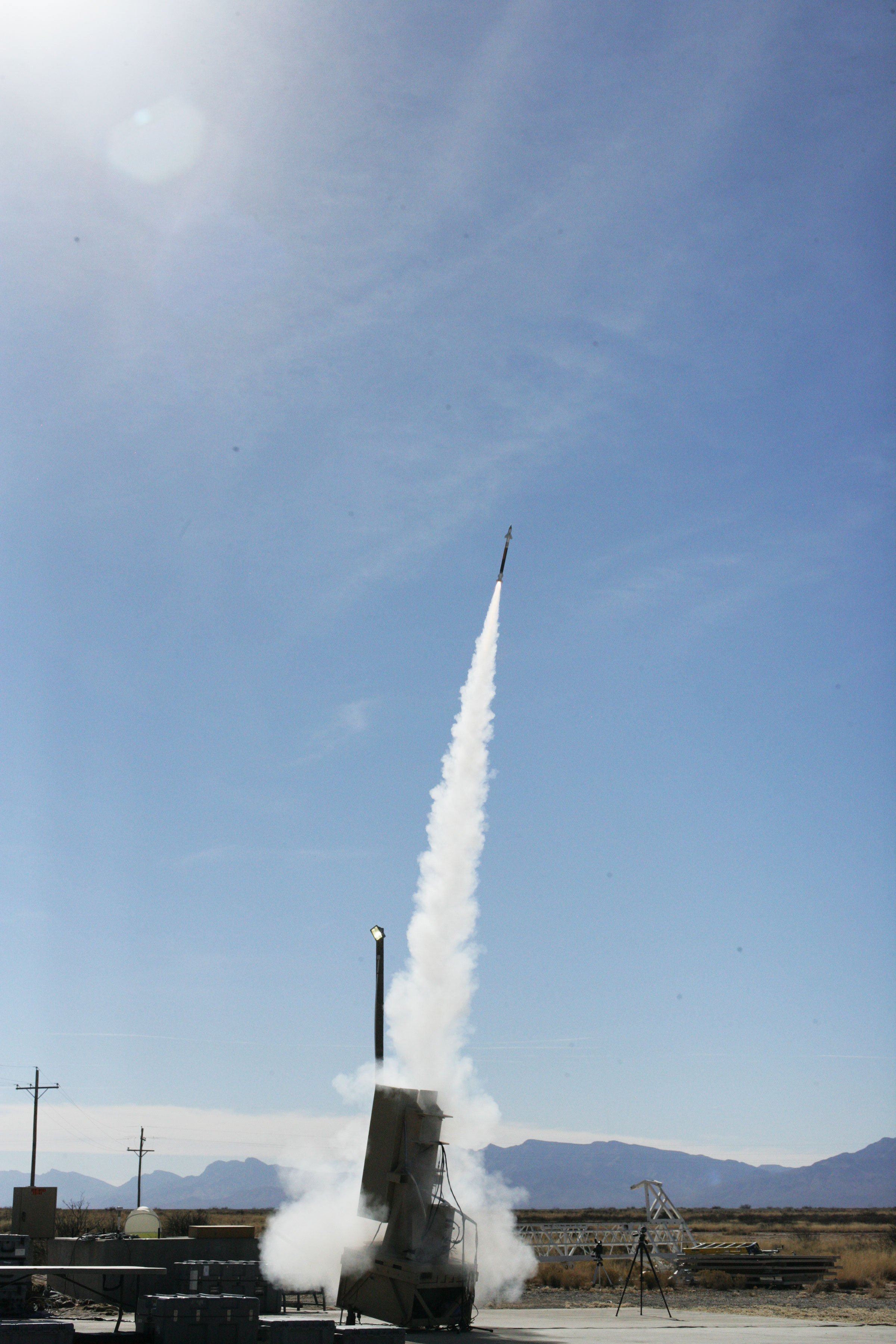
Facing a perfect storm of urgent needs, Undersecretary Ryan D. McCarthy helps lead the push to modernize the Army from the industrial age to the information age.
by Mr. Steve Stark
The six priorities that Ryan D. McCarthy, then acting secretary of the Army, unveiled last October are just Army fundamentals. “We shoot, we move, we communicate,” he said when Army AL&T visited him in his Pentagon office on Jan. 31. “Every army in the world has to do these things.”
It’s not that the U.S. Army doesn’t do these things well. It does. The problem is the equipment, which, after more than a decade and a half at war, and in some cases nearly 60 years of service, is just plain old. And during Operations Iraqi Freedom and Enduring Freedom, the Army used only a narrow segment of its ability to shoot, move and communicate. Plus, that period gave near-peer adversaries the opportunity to upgrade their own ability to shoot, move and communicate, while keeping a constant eye on U.S. capabilities. What the Army is facing now is a perfect storm of urgent needs.
And so, while the Army has its six priorities, McCarthy, now undersecretary of the Army, has a single priority: Modernize. Fast.
Even if the doctrine, requirements, research and development, acquisition, contracting, testing, and logistics process moved at a lightning pace, the Army has a lot of needs to fill. But that process, wherein generating a set of requirements alone can take half a decade or more—or, worst case, a decade or more—is anything but fast. That, in McCarthy’s estimation—a calculation he shares with Gen. Mark A. Milley, Army chief of staff; Dr. Mark T. Esper, Army secretary; and Gen. James C. McConville, the Army’s vice chief of staff—has to change. Changing it, McCarthy said, means changing the Army, and that means both structural and culture change.
Exactly what the realignment will look like has not been announced as of this writing. What has been established is that the Army plans to stand up the initial operational capability of a new Army Futures Command this summer. McCarthy’s Oct. 6 memo, which laid the groundwork for the new command and the cross-functional teams that will make up its core, established six main teams, one for each of the six modernization priorities. Army leadership is expected to announce details of the realignment March 26 at the Association of the United States Army (AUSA) Global Force Symposium and Exposition in Huntsville, Alabama.

ON THE SAME PAGE
McCarthy, left, has said that as long as he and Chief of Staff Gen. Mark A. Milley, right, are in office, they will continue to emphasize the Army’s six modernization priorities so that all stakeholders—including DOD, the Army acquisition enterprise and Congress—know and understand them. (U.S. Army photo by John G. Martinez)
THE FUNDAMENTALS
Given the mandate to shoot, move and communicate, “long-range precision fires; next-generation combat vehicles; future vertical lift; network communications; integrated air missile defense and Soldier lethality—this spans all fundamentals,” McCarthy said.
McCarthy emphasized that each of these priorities isn’t a single system, but a portfolio of capabilities. “If you think back to the big five [the Abrams tank, the Bradley Fighting Vehicle, the Apache attack and Black Hawk utility helicopters, and the Patriot missile defense system], it was really the big 64. There were five primary weapon systems. It was about another 59 programs that fell well underneath those capabilities—seriously.”
McCarthy is serious—and passionate—about the Army’s new big six. “If you look at the six priorities, long-range precision fires—there are several programs that fall under that. Future vertical lift could be tactical, it could be lift, it could be unmanned systems, but it’s all underneath that. Same thing [is] true with networks. Soldier lethality spans all fundamentals—shoot, move, communicate, sustain, protect. … It’s very important that we manage these like a portfolio of capabilities, so that we get an adequate hedge.” That hedge is an important part of a tech portfolio, especially if one line of inquiry turns out to be far more significant than reasonably anticipated at first.

READY IN ALL CONDITIONS
Soldiers with the 101st Combat Aviation Brigade (CAB), 101st Airborne Division (Air Assault) and the division’s 3rd Brigade Combat Team participate in a large-scale air assault training exercise in January at Fort Campbell, Kentucky, designed to demonstrate the ability to integrate land operations with air support. The Army’s new modernization priorities echo the fundamentals of shoot, move and communicate. Key to implementing those priorities are the cross-functional teams and the Army Futures Command. (U.S. Army photo by Sgt. 1st Class Andrew McClure, 101st CAB)
GETTING CHANGE DONE
How to make change happen in the Army to best effect modernization, McCarthy said, was on the table from the start of his discussions with Secretary of Defense James N. Mattis, who, he said, understood that “a critical element to America’s national defense is going to be a modernization program that’s focused against near-peer competitors. I knew this back when I interviewed with him in the spring, very early in the spring.”
It became abundantly clear at McCarthy’s confirmation hearing that modernization was going to be the most significant mission for the Army. “If you followed my confirmation testimony, I didn’t get a lot of questions, but the ones that I did were entirely about this subject,” he said.
But that subject was not a surprise to McCarthy. A graduate of the Virginia Military Institute, he was a U.S. Army Ranger who “went to war 17 years ago in a JSOC [Joint Special Operations Command] unit” in Afghanistan. Following his service, he earned an MBA, worked as a staffer on Capitol Hill, and for former Secretary of Defense Dr. Robert M. Gates during both the Bush and Obama administrations. Later he worked for Lockheed Martin Corp., so his passion for the Army is tempered only by his in-depth knowledge of the realities of the different aspects of acquisition.
In many ways, McCarthy approaches change in the Army both as someone who is Army green to the core, but also as a businessman. If the Army is to do its job, putting it in a position to do so is a business proposition. And, for McCarthy, a lot of business is relationships. Most important among those are his relationships with Milley and McConville.
“I have a very strong relationship with the chief and the vice [chief]. I’ve known them from a previous life, served with them before.” Those relationships helped him when he came into office to start to “move quickly, because there was trust already established. In one of my early conversations with the chief, I said, ‘You’ve got to nail down the priorities’ ” and then stick with them. Indeed, McCarthy said, he and Milley have agreed that for as long as they are in office, they will continue to hammer those six priorities so that everyone, from DOD to Congress to industry to the whole of the acquisition, logistics and technology enterprise, knows and understands them.
“We can’t change, because we need to have the system primed against these six capabilities. You’ve got to let industry know, you’ve got to let Congress know, you’ve got to let OSD [the Office of the Secretary of Defense] know about it so that they see the entire Army get into formation in phalanx and attack.” That’s exactly what is happening now, he said, even if decisions are still to be made.

WHAT’S COMING NEXT?
A Soldier assigned to the 3rd Cavalry Regiment scans for simulated enemies during Decisive Action Rotation 18-04 at the NTC in February, part of an emphasis on ensuring that warfighters remain ready for current and future contingencies. According to McCarthy, “a critical element to America’s national defense is going to be a modernization program that’s focused against near-peer competitors.” (U.S. Army photo by Spc. Esmeralda Cervantes, NTC Operations Group)
PORTFOLIOS AND TEAMS TO MATCH
McCarthy said that, in developing the portfolios of priorities, “We knew that we wanted to stand up cross-functional teams to support” each of them.
That unity of effort is critical, he said, because none of the stakeholders will take the Army seriously if it can’t outline what its No. 1, No. 2 and No. 3 priorities are. As long as Army modernization priorities are clear to industry and Congress, industry will understand what to invest in and Congress will know what to fund and why.
The cross-functional teams are intended to bring together “under one roof” all of the stakeholders in the acquisition enterprise: requirements, acquisition, science and technology (S&T), test and evaluation, resourcing, contracting, costing, acquisition logisticians and U.S. Army Forces Command, as well as Army service component commands as applicable, according to the Oct. 6 memo.
Each of the teams is led by a director who is a “post-brigade command-qualified officer.” That means someone at about the level of “a battle-hardened brigadier general,” as , although the leader of a cross-functional team could be a civilian. It also means that the user perspective will be represented on the team by someone who “has led in a tactical formation at the O-6 level, is more seasoned,” McCarthy said, adding, “… someone who has deployed recently and understands the key elements of how all of the weapon systems come together in a combined arms maneuver. So they understand not only the trade-offs, but how all the pieces come together like a clock to make it run.”
Cross-functional team leadership represents “that customer view, if you will.” This is a significant change for the Army and takes the notion that the user must be involved to its logical conclusion.
PERMISSION TO COMMUNICATE, DECIDE
For McCarthy, this is a critical part of the cross-functional team equation. Having an aviator lead the future vertical lift team may seem obvious, but having user-experts run programs is not something that the Army has done a lot of in the recent past.
Those cross-functional team leaders, he said, “understand how the tactical formation runs, but they are also working with each other, because ultimately what they’re doing is putting together the analytical rigor” in requirements, research and acquisition “to examine and decide the types of capabilities that you need within a given portfolio to help inform leadership to make the best decisions possible.”
The beauty of this, McCarthy said, is that it enables real-time decisions, unlike the bureaucracy-mired, business-as-usual Army that has been the status quo for far too long. For instance, McCarthy said, “If you had a requirements meeting and the PEOs [program executive offices] aren’t in there—well, they’re either going to get it verbally [later] or someone is going to hopefully take very good notes. That’s what we have done historically.” With the new construct, however, “now they are all in there at once. You’ve got the screens up and people are beaming in. You think you’re at a JOCC [joint operations command center] in Baghdad. I mean, everybody is there and they all hear it at once.”
That speeds decisions. “By doing it now, in real time, we compress the timeline.” What the cross-functional team concept does is push “the requirements community to take a much bigger step forward in formalizing the relationship with our PMs [program managers] and PEOs from the acquisition community.”
“And what is so important about it is that the formalizing of that relationship” between requirements and acquisition makes the process much more dynamic. Historically, it’s been “just this mechanical process where they write up a requirement and they send it down the path. Now we have relationships” on the cross-functional teams, and they have the “responsibility to be very clear in the definition and in the interpretation of a requirement. And [to] put the acquisition community in the best position possible to lead that development process and acquire the capabilities that we need.”
The cross-functional teams have been making decisions, he noted. “We’ve made decisions right there. We’ve moved millions of dollars, we’ve changed requirements—everything. Last fall we did an S&T review and we restructured the entire S&T budget of the Army in four days. Granted, that was with McConville and me. They spent weeks getting ready for us.
“But we made the decisions; we had all the players in the room. We aligned 80 percent of the S&T budget against the six priorities. So you see how we are trying to do this. We’re locking in on a set of priorities. We’re putting our money where our mouth is. We’re empowering our people. We’re bringing them closer together.”

WHAT PROGRESS LOOKS LIKE
The Miniature Hit-To-Kill interceptor missile leaves the launcher during a test at White Sands Missile Range, New Mexico, in January. Getting new technologies fielded faster requires both structural and cultural change, in McCarthy’s view; the shape of those changes will be spelled out later this year as development continues for the cross-functional teams and the Futures Command announced late last year. (Photo by Michael A. Smith, White Sands Missile Range Public Affairs)
MANY DESKS
A central issue with acquisition is the current disconnected disparity of the stakeholders, the variety of entities that are involved with weapon systems development, McCarthy said. “We have requirements, we have research and technology, we have all of the integration with that. And it’s spread across all of the major commands—that’s why it takes so long, because there’s a lot more people involved than just the acquisition community,” he noted.
Back in the spring, “when we went through this, we realized we’ve got to get all of this under one roof—or to start the process of getting it under one roof. I knew back in the spring [that] our PMs, they are hard-lined to ASA(ALT) [the Office of the Assistant Secretary of the Army for Acquisition, Logistics and Technology]. They will be owned by the acquisition organization. But what we need to do is cross-functional because that fuses” all of the elements. “It makes you faster—speed, collaboration, the movement of information. We are in the information age; we have an industrial system today. So this is how we get faster.”
This is one of McCarthy’s mantras: The Army has an industrial system today and it needs to get into the information age.
Each cross-functional team puts all of the elements under one roof to “reduce the time span” of bringing a capability, whatever it is, from concept to fruition. “It’s a very simple exercise,” McCarthy said. “How many desks does it have to go through, how many commands does it have to go through? It’s breathtaking how much energy comes into getting a requirement done.” There had to be a simpler way, “because otherwise it takes five to seven years.”
He continued, saying, “Take network, for example. How fast does information technology move? That iPhone in your pocket is probably already irrelevant. That’s how fast it goes. So I can’t wait seven years to get something locked in.”
PERMISSION TO INNOVATE
“The cross-functional team part is easy,” McCarthy said. “You get these subject matter experts from, like, the O-6 [colonel] to O-7 [brigadier general], O-8 [major general] level and they work this, and they perform the rigor and the analytics and they tee up decisions.”
The challenge, he said, is “upper middle management, senior management—guys like me that … people stay up all night putting presentations together for. How do you improve upon that?”
What the Army needs, McCarthy said, is an innovative organization to help “lead weapon systems development, the materiel development and design.”
“The challenge is, how do you separate concepts from materiel design?” And, “How do you snap-link the big parts of the Army together, or do you take it all out and put it in one place?” The answer: the Army Futures Command.

REPEAT AFTER ME
Defense Secretary James N. Mattis formally swears in Ryan D. McCarthy as the 33rd undersecretary of the Army during a ceremony at the Pentagon Sept. 5. The U.S. Senate confirmed McCarthy on Aug. 1, following hearings that centered mainly on the topic of modernization—something that came as no surprise to McCarthy. (DOD photo by U.S. Army Sgt. Amber I. Smith)
RESTRUCTURING, NOT REORGANIZATION
Precisely how Army organizations are going to look, or how that snap-linking or putting in one place is going to work, will remain open until announcements are made in Huntsville in March. “Those are all the things that are being deliberated on right now. We are going to make a decision by the end of February,” McCarthy said. “But that’s the hardest part here. If you did nothing at all and you kept the CFTs [cross-functional teams] today, that’s great, but they report to the vice chief and the undersecretary right now.” Which means that if they do not form the heart of a new Army Futures Command, their authority with all of the other stakeholders is minimal.
McCarthy said that it’s important to get the authorities within each of the disparate commands together to be able to make decisions quickly, which in turn will make modernization happen more quickly.
McCarthy’s background gives him 360-degree perspective and, he said, “helps me to facilitate a good discussion and to ensure that all the stakeholders get to weigh in and make the best-informed decision. But it also helps with the understanding of how to deal with the external stakeholders.” That includes not only the bigger, organizational decisions, but the smaller decisions on which weapon systems to prioritize. And in that case, there are lots of hoops to pass through.
“We’ve got to get it out of the Army to get it to OSD. We’ve got to get it out of OSD to get it to Congress. We’ve got to negotiate with vendors. I’ve sat at every one of those major angles within the prism, if you will, so that helps a great deal. It helps me be the conductor in the process.”
That process now includes shaping how the Army develops the Futures Command. “Normally in government you always hear ‘reorganization,’ ” McCarthy said. “It’s like deck chairs moving around. In the private sector—and this is important—it’s restructuring. The commands will still stay there. There are aspects or roles and responsibilities within those commands that may go over here.”
This is where McCarthy’s business acumen, his relationships on Capitol Hill and his knowledge of the process come in handy. At an appearance at the Brookings Institution on Feb. 8, he said that the Army is keeping Congress informed because some of the restructuring that the Army is envisioning may require legislation. “You’re now getting into where we’re deliberating at the senior level to the final end state, what it’s going to be,” he said.

WHAT’S COMING NEXT?
A Soldier assigned to the 3rd Cavalry Regiment scans for simulated enemies during Decisive Action Rotation 18-04 at the NTC in February, part of an emphasis on ensuring that warfighters remain ready for current and future contingencies. According to McCarthy, “a critical element to America’s national defense is going to be a modernization program that’s focused against near-peer competitors.” (U.S. Army photo by Spc. Esmeralda Cervantes, NTC Operations Group)
CHANGING ARMY CULTURE
The changes envisioned also include a major culture change. “Normally,” McCarthy said, “when you want to make a change in life, if it’s on your terms, it’s OK. But if it’s somebody coming and sliding a memo across the table,” that’s a different matter. To successfully make that kind of change, he said, “Then you’ve got to get them to buy into it. You’ve got to have a conversation. You’ve got to emphasize to them why we’ve got to make the changes that we do.”
Since the fall, McCarthy has been having just those kinds of conversations. It’s important, he said, for people “to understand the rationale behind” the coming changes. “When the leader gets out and has the conversation, one adult to another, ‘Here’s where we are trying to go,’ you learn.” That give and take—his own education as well as that of the Army’s stakeholders—is important to McCarthy. To make change happen, he said, “you have to listen and learn. And you also adjust. It will help make the best decision possible.” As an example, he said, he’s had roundtables with the PEOs. “They gave me a lot of good ideas,” he said.
“When we get to the announcement” of what the Futures Command will look like, he added, “it will require town halls or roundtables” to make sure that his message is clear and people understand what he’s looking for.
CONCLUSION
On the wall behind his desk, in his otherwise sparsely furnished office, McCarthy keeps a glass-encased M-1 Garand. The weapon was the U.S. Army’s go-to rifle in World War II, the Korean War and saw some use in Vietnam. For McCarthy, the elegantly simple and effective semi-automatic weapon is a reminder of just how effective Army acquisition can be.
The acquisition community, he said, does “remarkable things. What I would ask them is just to afford me the time and the patience to go through this process.” He knows that change is hard, but getting the Army into the information age is critical. “When you’re making changes in big organizations, it takes time. And I know people are anxious about where we’re going.” Everyone should understand that many decisions are still to be made and should afford leadership—Esper, McCarthy, Milley and McConville“the opportunity to talk them through the changes.”
That includes the S&T community, he said. He wants to see scientists and technologists working on systems that they know the Army is driving for, “and they are going to see it on their watch. There is no better way to incentivize somebody, especially the scientific and engineering community. They like to study and make things, but they like to see it fly, they want to see it explode, they want to see it drive.” And McCarthy wants to see that happen.
He made it clear that he holds the workforce in the highest esteem. “We have very talented people. We have tremendous capital investment. It’s getting them all aligned. And once we do that, I have no doubt we will do really special things faster. We do special things now; it’s just taking too long.” With respect to acquisition leadership, he said, “We have been blessed. The cross-functional team directors and the PEOs that are playing in this, they are the best we have, the best people we have.”
STEVE STARK is senior editor of Army AL&T magazine. He holds an M.A. in creative writing from Hollins University and a B.A. in English from George Mason University. In addition to more than two decades of editing and writing about the military and S&T, he is the best-selling ghostwriter of several consumer health-oriented books and an award-winning novelist.
This article is published in the April – June 2018 issue of Army AL&T magazine.
Subscribe to Army AL&T News, the premier online news source for the Acquisition, Logistics, and Technology (AL&T) Workforce.







